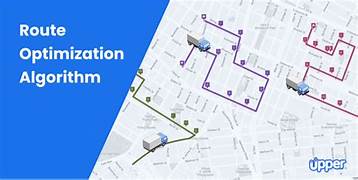Real-Time Traffic Analysis and Route Optimization with AI: Revolutionizing Modern Transportation
The global rise in urbanization and vehicle usage has led to a sharp increase in traffic congestion, air pollution, and inefficient transportation systems. The need for smarter, more efficient traffic management solutions has never been more critical. Enter Artificial Intelligence (AI): a transformative technology that is reshaping how cities and transportation systems address these challenges. Real-time traffic analysis and route optimization powered by AI are paving the way for faster commutes, reduced environmental impact, and improved urban mobility.
This article explores how AI is revolutionizing traffic management, the technologies enabling these advancements, real-world applications, and the challenges and future prospects of AI-driven traffic solutions.
The Problem with Traditional Traffic Management Systems
Conventional traffic management systems often rely on static data and pre-programmed signals, which are unable to adapt dynamically to real-world conditions. These systems face significant limitations:
- Reactive Approach: They respond to traffic situations after they occur rather than predicting or preventing them.
- Limited Scalability: Traditional methods struggle to accommodate rapidly growing urban populations and the corresponding surge in vehicles.
- Inefficiency: Fixed signal timing and lack of integration with real-time data sources lead to bottlenecks and delays.
To address these shortcomings, AI introduces dynamic, data-driven solutions that can analyze, predict, and optimize traffic flow in real time.
How AI Powers Real-Time Traffic Analysis
AI leverages advanced technologies like machine learning, computer vision, and big data analytics to provide real-time insights into traffic patterns. Here’s how these technologies work together:
1. Data Collection and Integration
AI systems gather vast amounts of traffic data from various sources, including:
- Cameras and Sensors: Installed on roads and intersections to monitor vehicle movement, speed, and density.
- GPS Devices: Found in vehicles and smartphones, providing location data and travel speeds.
- Social Media and Apps: Offering crowd-sourced traffic updates and incident reports.
- Weather Data: Factoring in conditions that influence driving behavior and traffic flow.
2. Machine Learning Algorithms
Machine learning models process this data to identify patterns, predict congestion, and suggest optimized routes. These algorithms improve over time, becoming more accurate as they learn from historical and real-time traffic data.
3. Predictive Analytics
AI systems use predictive models to anticipate traffic conditions, such as rush hours, accidents, or road closures. These predictions enable proactive measures to mitigate congestion.
4. Computer Vision
Cameras equipped with AI-powered computer vision can identify and classify vehicles, pedestrians, and other road users, helping manage traffic more efficiently. For example, systems can detect traffic violations or identify vehicles involved in incidents.
Route Optimization with AI
Route optimization involves finding the most efficient path for a vehicle to reach its destination, considering factors like distance, time, fuel efficiency, and traffic conditions. AI enhances this process through:
1. Dynamic Route Planning
AI analyzes real-time traffic data to identify the quickest and least congested routes. Unlike static GPS systems, AI-based navigation apps like Google Maps and Waze continuously update routes based on current conditions.
2. Multi-Objective Optimization
AI can balance multiple objectives, such as minimizing travel time, reducing fuel consumption, and avoiding toll roads. This feature is particularly beneficial for logistics companies aiming to cut costs and improve delivery efficiency.
3. Integration with Smart Infrastructure
AI integrates with smart city infrastructure, such as adaptive traffic signals, to provide end-to-end route optimization. For instance, traffic lights can adjust their timing to create green waves, enabling smoother traffic flow along a route.
Real-World Applications of AI in Traffic Management
AI-powered traffic analysis and route optimization are already making a significant impact in various sectors:
1. Urban Traffic Control
Cities like Los Angeles, Singapore, and Amsterdam are using AI to manage complex traffic systems. AI-controlled traffic lights adapt to real-time conditions, reducing wait times and congestion.
2. Ride-Sharing and Delivery Services
Companies like Uber, Lyft, and Amazon rely on AI to optimize routes for drivers, reducing delivery times and improving customer satisfaction. AI also helps manage fleet operations, ensuring vehicles are deployed where demand is highest.
3. Incident Management
AI systems can detect accidents or breakdowns through camera feeds and sensors, alerting authorities and redirecting traffic to prevent further congestion.
4. Public Transportation
AI optimizes bus and train schedules based on passenger demand and traffic conditions, improving reliability and reducing overcrowding.
5. Environmental Benefits
AI-driven traffic solutions contribute to environmental sustainability by reducing fuel consumption and emissions. For example, smoother traffic flow leads to fewer stops and starts, which are major sources of pollution.
Challenges in Implementing AI for Traffic Management
While the benefits of AI in traffic management are undeniable, several challenges must be addressed to ensure successful implementation:
1. Data Privacy and Security
Collecting and analyzing real-time traffic data involves handling sensitive information, such as location and travel history. Ensuring data privacy and protection is critical to maintaining public trust.
2. Infrastructure Costs
Implementing AI-driven systems requires significant investment in sensors, cameras, and other infrastructure. Budget constraints can hinder adoption, especially in developing regions.
3. Integration with Legacy Systems
Many cities rely on outdated traffic management systems that are incompatible with modern AI technologies. Upgrading these systems can be a complex and time-consuming process.
4. Algorithmic Bias
AI models can unintentionally favor certain routes or regions, leading to unequal traffic distribution and potential socio-economic disparities.
5. Dependence on Data Quality
The effectiveness of AI systems depends on the quality and accuracy of the data they receive. Inconsistent or incomplete data can compromise their performance.
Future Prospects for AI in Traffic Management
The future of AI in traffic management looks promising, with advancements expected in several areas:
1. Autonomous Vehicles
Self-driving cars equipped with AI will revolutionize traffic flow by communicating with each other and traffic management systems. This will reduce accidents and optimize road usage.
2. Integration with IoT
The Internet of Things (IoT) will enable seamless communication between vehicles, traffic infrastructure, and AI systems, enhancing real-time traffic analysis.
3. AI-Powered Mobility-as-a-Service (MaaS)
AI will play a central role in MaaS platforms, which integrate various transportation modes into a single service. This will make travel more efficient and user-friendly.
4. Enhanced Predictive Models
Future AI systems will use even more sophisticated algorithms to predict traffic patterns with greater accuracy, allowing cities to plan infrastructure and policies proactively.
5. Green Transportation
AI will contribute to the development of eco-friendly transportation solutions, such as optimizing routes for electric vehicles and supporting smart charging infrastructure.
Conclusion
AI-driven real-time traffic analysis and route optimization are transforming the way we navigate and manage urban transportation systems. By leveraging advanced technologies like machine learning, computer vision, and IoT, these systems offer unparalleled efficiency, safety, and environmental benefits. However, challenges such as data privacy, infrastructure costs, and integration hurdles must be addressed to fully realize their potential.
As AI continues to evolve, it will play an increasingly vital role in shaping the future of transportation. With the right policies and investments, AI can create smarter, more sustainable cities, improving the quality of life for millions of people worldwide. The journey toward AI-powered traffic management is not without its roadblocks, but the destination promises a smoother, greener, and more connected future.


